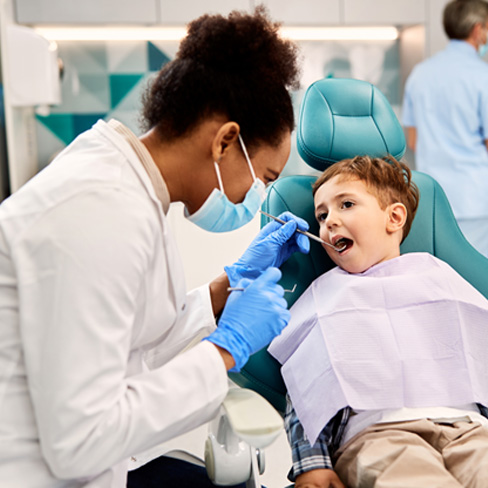Pulp Therapy Towson
Saving Damaged Teeth & Protecting Young Smiles
At Kids Dental Space in Towson, we are committed to helping young smiles thrive. Sometimes, that means we have to extract teeth — but we try to avoid that outcome whenever possible. That is why Dr. Clarke and our team are proud to offer pulp therapy, a restorative service that can remove infected tissue, resolve a toothache, and support your child’s overall oral health. Continue reading below to learn more about this service and how it works, or contact us directly to ask questions. We look forward to hearing from you!
Does Your Child Need Pulp Therapy?

Pulp therapy aims to address issues within the pulp of a tooth, which is the soft inner layer that is home to nerves, blood vessels, and connective tissues. The only way to know for sure if your child needs pulp therapy is to bring them in for an evaluation with a qualified dental team. However, there are some signs you can look for that may point to the need for this treatment:
- Your child is complaining of a toothache or exhibiting signs of dental distress.
- Your child’s teeth are highly sensitive to hot and cold foods.
- You see visible damage on one of your child’s teeth. For example, you might notice a crack or chip.
- The tissue around the tooth is red and swollen.
- The tooth appears discolored.
- There is a bump on the gums near the tooth.
The Pulp Therapy Process

Because we want your child to be comfortable, we will start their appointment by administering local anesthesia to numb their mouth. We may also provide sedation to help them remain calm and relaxed throughout the procedure. Then, we can get to work.
The details of the treatment will depend on the condition of your child’s tooth. There are two main types of pulp therapy:
- If the tooth is still alive (still has blood flow and responds to temperature changes), we might recommend a pulpotomy. We will remove the pulp from the tooth’s crown, leaving the roots untouched. This procedure is often done on baby teeth in order to preserve them until they are ready to naturally fall out.
- If the tooth is no longer alive, we might perform a pulpectomy. We will remove all the pulp from the tooth, including the roots. In many ways, this service is similar to a root canal for adults.
After either type of pulp therapy, the tooth may need a crown to protect it from additional damage.
The Benefits of Pulp Therapy

Some of the biggest benefits of pulp therapy include:
- Pain relief: Pulp therapy can alleviate your child’s toothache, helping them feel comfortable again.
- Prevents infection spread: Treating the infected pulp stops bacteria from causing further oral health issues.
- Saves natural teeth: Preserving your child’s tooth maintains their smile and supports healthy jaw development.
- Promotes normal eating: A treated tooth allows your child to chew and eat without discomfort or significant dietary limitations.
- Supports speech development: Keeping baby teeth helps your child articulate sounds and words correctly as they grow.

